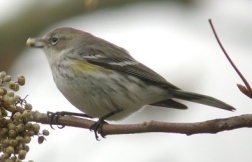|

Medium warbler, dark-streaked,
blue-gray upperparts, yellow rump.
White throat and belly, black breast.
The head is black with yellow crown, white eye-rings, and faint eyestripes.
Wings are dark with yellow shoulder patches and two white bars.
Tail is dark with white corners.
The Audubon Yellow-rumped
Warbler has a yellow throat and lacks white eyestripe.
|
YELLOW-RUMPED
WARBLER
Dendroica coronata
PASSERIFORMES
Wood Warblers (Parulidae)
Range and Habitat
Breeds from northern Alaska, northern Manitoba, central Quebec, and
Newfoundland south and west to northern Mexico and east to Michigan,
northern New York, Massachusetts, and Maine. Spends winters from the
southern part of its breeding range southward into the tropics. A highly
adaptable bird found in a variety of habitats including coniferous forests,
mixed woodlands, deciduous forests, pine plantation, bogs, forest edges,
and openings. In the winter, it is often found in brushy thickets of
bayberry and wax myrtle.
SOUND:
"chek"
The Yellow-rumped
Warbler is one of the most common warblers in North America. The eastern
Myrtle and western Audubon forms were once considered separate species.
Easily identified from one another, the Myrtle has a white throat, while
the Audubon’s is yellow.
Able to digest 80% of wax-coated berries such as bayberries, the Yellow-rumped
Warbler is capable of wintering farther north than any other warbler.
A group of warblers has many collective nouns, including a "bouquet",
"confusion", "fall", and "wrench" of warblers.
 
The Yellow-rumped
Warbler has a tremendous range reaching up to generally 9.8 million
kilometers. This bird can be found in much of the Caribbean as well
as parts of North, and Central America including Bahama, Belize, Cayman
Islands, Colombia, Costa Rica, Cuba, Dominican Republic, El Salvador,
Guatemala, Haiti, Honduras, Jamaica, Mexico, Nicaragua, Panama, Puerto
Rico and others. There are also vagrant populations in Greenland, Iceland,
Ireland, the Netherlands, Portugal, Spain and the UK. Its preferred
habitat includes temperate, tropical and subtropical forests, shrublands
and even rural gardens.
The global population of this bird is estimated to be around 90 million
individuals. It is not believed that the population trends for this
species will soon approach the minimum levels that could suggest a potential
decline in population. Due to this, population trends for the Yellow-rumped
Warbler have a present evaluation level of Least Concern.

|